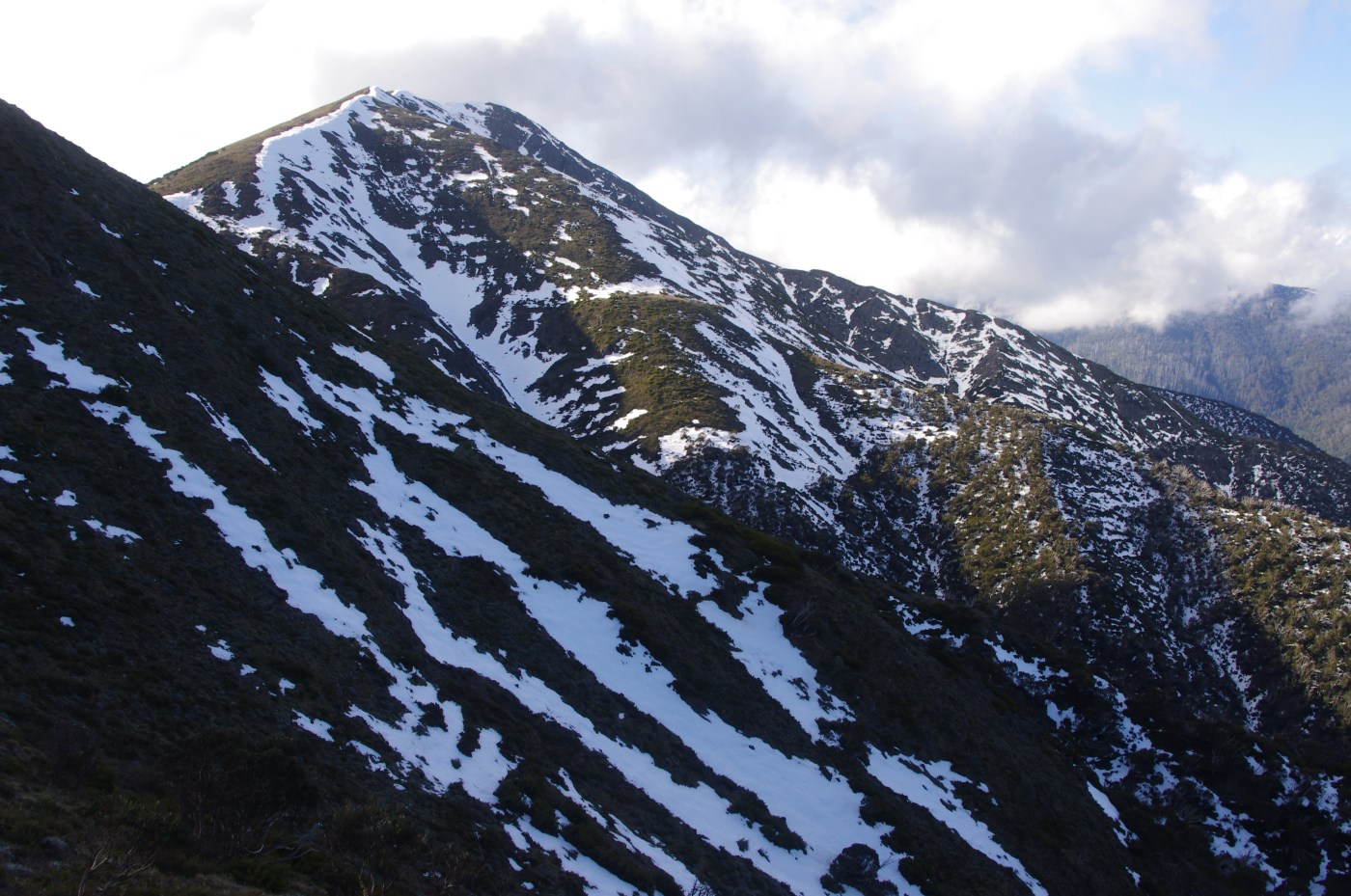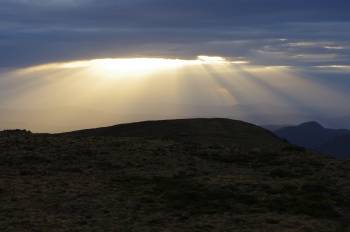I am keenly aware that no Aboriginal group or nation ever ceded it’s land to the colonisers. So those of us living in Australia are all living on stolen land. There is a lot of unfinished business that needs to be resolved, starting with negotiating a meaningful treaty between First Nations and the rest of the people living on this continent.
For a long time, indigenous people and traditions were white washed out of mainstream narratives about the mountains. As traditional owner groups reassert their connection to Country, that is slowly changing, and we can see it across the Alps. The first Aboriginal person I knew who had a strong connection to the mountains was Eddie Kneebone, who I met through our campaign work in north east Victoria in the 1990s. He had an astonishing depth of knowledge. He was instrumental in the campaign to have the Niggerheads on the Bogong High Plains renamed. It got me thinking about the power of language and names.
Recently I was looking for an indigenous name for Mt Feathertop. I couldn’t find one. While public awareness of the traditional name for Mt Bogong is growing, there are vast gaps in the knowledge base that we hold about names. In the Waywurru and Dhudhuroa languages, Mt Bogong is named Warkwoolowler, meaning the mountain where Aboriginal people collected the Bogong Moths. (source). I hope that, over time more places will receive formal dual naming as has happened with The Grampians/ Gariwerd in the west of the state.
Despite massacres and dispossession after the arrival of Europeans, many First Nations people managed to hold connection to the high country, and communities are reasserting that connection now. The Victorian government’s Right People for Country program is assisting First Nations to identify the boundaries of their country. Because so many nations shared the Alps, there was also shared country, and in recent years, traditional owners across the state have been discussing where each nation ends and what areas are shared.
The Gunaikurnai and Taungurung Traditional Owner groups have connection to the Victorian Alps over thousands of generations, and in recent years they have sought support from the Victorian government’s Right People for Country program to help clarify the boundaries between their respective countries.
Other groups are also reasserting their connection.
As non indigenous people, the least we can do is support this process however we can. One small way to do this is to support efforts to use dual naming for places in the landscape where traditional names are still known.
In future, Mountain Journal will make an effort to identify the traditional name for places named on the website.
Because mountain areas are often shared country, there are often several names for the same feature, so this will be a complex and, at times, fraught process. But that’s OK. There have been disagreements about the renamed ‘Niggerheads’. And in the Snowy Mountains there is a process underway at present which is seeking to identify a traditional name for Mt Kosciuszko which is acceptable to all Monaro-Ngarigo People.
In other places it will be fairly easy. For instance, in lutruwita (Tasmania), there are already 14 official Aboriginal or dual names in the state. These names are in palawa kani, the revived language of Tasmanian Aborigines. (Although this article covers some of the difficulties in reconstructing language, and this one covers some of the politics of aiming for dual naming).
Resources
I would really appreciate you sending links to dual and/or Indigenous names of landscape features in the Australian Alps and lutruwita/ Tasmania. I will add them as I get them. Please send to cam.walker@foe.org.au
- Indigenous names from lutruwita/ Tasmania (known place names located on a map). Source: Tasmanian Aboriginal Centre.
I look forward to us all deepening our connections to the Australian mountains as we learn more from First Nations people.
























































August 20, 2020 at 9:17 pm
Personally I’d be very happy to have Feathertop keep it’s name, its so descriptive of the plume of snow blowing over the cornices. How PC are we going to become? After all our mountains/rivers/localities survived for millions of years without names before the group of occupiers before the whites arrived, about 40-60,000 years ago. In logic, why privilege one group of namers over another? The name is irrelevant, it’s protecting the thing that is important.
[From Cam. Yes agreed, Feathertop is a lovely name. But this article is about dual naming, not replacing existing names. We already privilege one group because we only use the names from one group – ie Europeans. Why is it a problem if we provide the same right to others? I would love to see Bogong renamed Bogong/ Warkwoolowler]
August 21, 2020 at 11:56 am
I agree wholeheartedly Cam. Let’s get the wheels moving by dual naming in maps and signs. That will het the notion out there and allow people to search for either online/maps and thus start using them in day to day conversations. It will take time. Look how long Uluru took to stick.
May 26, 2021 at 11:12 am
I thought Bogong was an indigenous word for ‘Big Fella’ because it looks so large compared to other mountains. At some point in history a European has sought from an indigenous authority the mountain’s name… should that not take precedence? It is a name that was given long ago and so is closer to life before Europeans and closer to the Dreaming. Is it not possible that Warkwoolowler is a modern construct from indigenous communities that is undermining the first name given from their ancestors? Such naming histories need good research reference points.
I think if there is no evidence of an original name for Feathertop, then a fabricated one is tokenism and slightly condescending or patronising to appease. The mountain is so well hidden and the terrain so difficult in winter that perhaps it was considered too sacred to walk on so wasn’t named?
[From Cam. hi Peter, yes I have also heard the ‘Big Fella’ story for years. As I understand it there are at least two groups with connection to Bogong, and Warkwoolowler is being put forward by Dhudhuroa, so you would really need to check with them if you think the name is ‘undermining the first name’.]
August 21, 2020 at 11:49 am
Whilst I agree with your notion of protesting the thing…. the mountain and by extension the ecology and planet. Why not respect the indigenous people who have not only occupied this continent before us, named the various places and have looked after it in a manner that put our efforts to shame?
August 21, 2020 at 11:50 am
Sorry its a typo protesting should read protecting
August 21, 2020 at 12:34 pm
I really like the idea of dual naming where appropriate and would support it (eg we don’t need to reinforce original racist names). You normalise through repetition and exposure.
August 21, 2020 at 1:15 pm
I remember the furore over Mount Niggerhead being renamed to the Jaithmathangs. See article: https://www.smh.com.au/national/aboriginal-group-outraged-over-naming-of-mountain-20081117-68gq.html
We need to be mindful that some of our mountains may have many different names, depending on the language groups in the area, and that by using one groups name, you may just be disrespecting another.
I’m all for using traditional names, we just need to be mindful about what name we ‘Europeans’ choose to use.
[From Cam. Yes, fully agree, David. If you read the article you will see I did reference the Niggerhead debate, and attempt to point out that sometimes there is disagreement over the name, or multiple names (eg the Kosci example). There is no suggestion in the story that non indigenous people should choose which names to use].
August 23, 2020 at 10:36 am
Great article Cam – you have outlined the complexities and sensitivities of this issue well. Of course “official” naming on maps etc. is important, but as Sonya points out, repeated use of a name in the community normalises it too. If you are confident with the acceptance of the name Warkwoolowler amongst traditional owner groups, perhaps the Bogong club will adopt it and add it to signage around Cleve Cole hut. I am ready to start using the name Warkwoolowler. Can you offer any guidance on the correct pronunciation? Dave
[Thanks Dave. Thats wonderful. I will see what I can find out re pronunciation. regards Cam]
October 9, 2023 at 1:22 pm
Thanks Cam for elucidating this worthwhile initiative. It may prove difficult or challenging at times but that’s no reason not to try and do it. I read somewhere that some first nations people weren’t prepared to divulge the names of many of their important places to the uninitiated because knowing the name conferred some sort of power/ownership. And when early European “explorers” were “guided” through country their guides (trying to steer them clear wherever possible from sacred places) would respond to requests for the native names of various geographical features by responding in language not understood by the Europeans with words such as “don’t ask for that information” or something much blunter as they tried to get them off their country asap